Development of Sustainable Creative Three-Dimensional Virtual Woven Textiles Using Clothing Waste
Abstract
:1. Introduction
1.1. Background of Clothing Waste Recycling Solution
1.2. Sustainability and Three-Dimensional Digital Fashion Connectivity
1.3. The Preceding Research and Research Motivation of This Study
1.4. Research Objectives and Research Process
- To examine if the clothing waste is easy to prepare and suitable for weaving;
- To examine the difficulty of the design method;
- To examine the novelty and appropriateness of the resulting textile.
2. Participant and Preliminary Survey
2.1. Participants of the Preliminary Survey, Weaving, and Evaluation
2.2. Preliminary Survey for Perception of the Recycling of Clothing Waste
3. Methods and Materials
3.1. Weaving Design Methods
3.2. Materials and Preparation of Weaving Production
3.3. Production of 3D Virtual Textiles
3.4. Evaluation
4. Results
4.1. Evaluation of Materials and Methods
4.2. Evaluation of Creative Textiles and 3D Virtual Textiles
4.3. Results of Focus Group Interview Discussion
5. Conclusions
Funding
Institutional Review Board Statement
Informed Consent Statement
Data Availability Statement
Conflicts of Interest
References
- Dissanayake, D.G.K.; Weerasinghe, D.U. Fabric waste recycling: A systematic review of methods, applications, and challenges. Mater. Circ. Econ. 2021, 3, 1–20. [Google Scholar] [CrossRef]
- Chuayjuljit, S.; Su-uthai, S.; Charuchinda, S. Poly (vinyl chloride) film filled with microcrystalline cellulose prepared from cotton fabric waste: Properties and biodegradability study. Waste Manag. Res. 2010, 28, 109–117. [Google Scholar] [CrossRef] [PubMed]
- Vadicherla, T.; Sa Patti, A.; Cicala, G.; Acierno, D. Eco-sustainability of the textile production: Waste recovery and current recycling in the composites world. Polymers 2020, 13, 134. [Google Scholar]
- Shuhua, W.; Xiaoying, Y.; Xiaogang, C.; Wensheng, H.; Mei, N. Recycling of cotton fibers separated from the waste blend fabric. J. Nat. Fibers 2020, 17, 520–531. [Google Scholar] [CrossRef]
- Leonas, K.K. The use of recycled fibers in fashion and home products. In Textiles and Clothing Sustainability; Springer: Singapore, 2017; pp. 55–77. [Google Scholar]
- Meng, X.; Fan, W.; Ma, Y.; Wei, T.; Dou, H.; Yang, X.; Tian, H.; Yu, Y.; Zhang, T.; Gao, L. Recycling of denim fabric wastes into high-performance composites using the needle-punching nonwoven fabrication route. Text. Res. J. 2020, 90, 695–709. [Google Scholar] [CrossRef]
- Panda, S.K.B.C.; Sen, K.; Mukhopadhyay, S. Sustainable pretreatments in textile wet processing. J. Clean. Prod. 2021, 329, 129725. [Google Scholar] [CrossRef]
- Niinimäki, K.; Hassi, L. Emerging design strategies in sustainable production and consumption of textiles and clothing. J. Clean. Prod. 2011, 19, 1876–1883. [Google Scholar] [CrossRef]
- Park, J.H.; Kim, Y.H. A Study on fashion design for up-cycled waste resources. J. Korean Soc. Costume 2014, 64, 138–154. [Google Scholar] [CrossRef] [Green Version]
- Zhi, Y. The Upcycling and reconstruction of garments and fabrics. Art Des. Rev. 2021, 10, 72–102. [Google Scholar] [CrossRef]
- Lewis, T.L.; Park, H.; Netravali, A.N.; Trejo, H.X. Closing the loop: A scalable zero-waste model for apparel reuse and recycling. Int. J. Fash. Des. Technol. Educ. 2017, 10, 353–362. [Google Scholar] [CrossRef]
- Jung, H.; Park, J. Zero-waste design of PartspARTs IMSEONOC. J. Korean Soc. Fash. Des. 2015, 15, 171–186. [Google Scholar]
- Kim, J.; Kim, H. A study on zero waste fashion design that applied puzzle cutting method. J. Fash. Des. 2018, 18, 37–55. [Google Scholar]
- Kushwaha, S.; Swami, C. Upcycling of leather waste to create upcycled products and accessories. Int. J. Home Sci. 2016, 2, 187–192. [Google Scholar]
- Štefko, R.; Steffek, V. Key issues in slow fashion: Current challenges and future perspectives. Sustainability 2018, 10, 2270. [Google Scholar] [CrossRef]
- Yang, S.; Song, Y.; Tong, S. Sustainable retailing in the fashion industry: A systematic literature review. Sustainability 2017, 9, 1266. [Google Scholar] [CrossRef] [Green Version]
- Wongpakdee, P. Art without Waste: 500 Upcycled and Earth-Friendly Designs; Rockport Publishers: Beverly, MA, USA, 2014. [Google Scholar]
- Sung, K.; Cooper, T. Sarah Turner–Eco-artist and designer through craft-based upcycling. Craft Res. 2015, 6, 113–122. [Google Scholar] [CrossRef] [Green Version]
- Janigo, K.; Wu, J.; DeLong, M. Redesigning fashion: An analysis and categorization of women’s clothing upcycling behavior. Fash. Pract. 2017, 9, 254–279. [Google Scholar] [CrossRef]
- Gazzola, P.; Pavione, E.; Pezzetti, R.; Grechi, D. Trends in the fashion industry. The perception of sustainability and circular economy: A gender/generation quantitative approach. Sustainability 2020, 12, 2809. [Google Scholar] [CrossRef] [Green Version]
- Cross, K.; Steed, J.; Jiang, Y. Harris Tweed: A glocal case study. Fash. Style Pop. Cult. 2021, 8, 475–494. [Google Scholar] [CrossRef]
- Amin, N.; Husain, A.; Shaari, Z.; Vermol, V. Strategizing alternative visual artworks medium through upcycle textile. Environ. Behav. Proc. J. 2021, 6, 73–80. [Google Scholar] [CrossRef]
- Penz, E.; Drewes, K.L. What shapes pro-environmental attitudes and intention for sustainable fashion consumption during a stressful time event? Sustainability 2022, 14, 15331. [Google Scholar] [CrossRef]
- Kim, Y.; Suh, S. The core value of sustainable fashion: A case study on “Market Gredit”. Sustainability 2022, 14, 14423. [Google Scholar] [CrossRef]
- Lee, H.W. A study on the production methods of upcycling tweed fabric using clothing waste based on Chanel’s tweed design. Sustainability, under review.
- Särmäkari, N. Digital 3D fashion designers: Cases of atacac and the fabricant. Fash. Theory 2021, 1–30. [Google Scholar] [CrossRef]
- Farren, A.; Hutchison, A. Digital clothes: Active, dynamic, and virtual textiles and garments. Textile 2004, 2, 290–307. [Google Scholar] [CrossRef]
- Ancutiene, K.; Strazdiene, E.; Lekeckas, K. Quality evaluation of the appearance of virtual close fitting woven garments. J. Text. Inst. 2013, 105, 337–347. [Google Scholar] [CrossRef]
- Ju, K.; Jeong, Y. Usage & education of the CLO3D virtual clothing program in the development office & academic. Fash. Inf. Technol. 2016, 13, 51–59. [Google Scholar]
- Choi, K. 3D Dynamic fashion design development using digital technology and its potential in online platforms. Fash. Text. 2022, 9, 1–28. [Google Scholar] [CrossRef]
- Papahristou, E.; Bilalis, N. Should the fashion industry confront the sustainability challenge with 3D prototyping technology. Int. J. Sustain. Eng. 2017, 10, 207–214. [Google Scholar] [CrossRef]
- Lee, Y. Transformation of the innovative and sustainable supply chain with upcoming real-time fashion systems. Sustainability 2021, 13, 1081. [Google Scholar] [CrossRef]
- Noble, S.; Mende, M.; Grewal, D.; Parasuraman, A. The Fifth Industrial Revolution: How harmonious human–machine collaboration is triggering a retail and service [R]evolution. J. Retail. 2022, 98, 199–208. [Google Scholar] [CrossRef]
- Ro, J. Characteristics of handicraft in contemporary fashion from the viewpoint of social-ecology. J. Basic Des. Art 2016, 17, 101–112. [Google Scholar]
- Bigolin, R.; Blomgren, E.; Lidström, A.; Malmgren de Oliveira, S.; Thornquist, C. Material Inventories and Garment Ontologies: Advancing Upcycling Methods in Fashion Practice. Sustainability 2022, 14, 2906. [Google Scholar] [CrossRef]
- Judson, G. Weaving ecologies for learning: Engaging imagination in place-based education. In Ecologies for Learning and Practice; Routledge: Abingdon-on-Thames, UK, 2019; pp. 32–45. [Google Scholar]
- Mamidipudi, A. Crafting innovation, weaving sustainability: Theorizing Indian handloom weaving as sociotechnology. Comp. Stud. South Asia Afr. Middle East 2019, 39, 241–248. [Google Scholar] [CrossRef]
- Memon, H.; Ranathunga, G.; Karunaratne, V.; Wijayapala, S.; Niles, N. Sustainable Textiles in the Past “Wisdom of the Past: Inherited Weaving Techniques Are the Pillars of Sustainability in the Handloom Textile Sector of Sri Lanka”. Sustainability 2022, 14, 9439. [Google Scholar] [CrossRef]
- Barooah, N.; Dedhia, E. Study of socio-economic status of women engaged in handloom weaving and measures for enhancing their sustainability. Int. J. Res. Soc. Sci. 2015, 5, 653–665. [Google Scholar]
- Kamble, Z.; Behera, B.K. Upcycling textile wastes: Challenges and innovations. Textile Progress 2021, 53, 65–122. [Google Scholar] [CrossRef]
- Kumar, B.; Hu, J. Woven fabric structures and properties. In Engineering of High-Performance Textiles; Woodhead Publishing: Sawston, UK, 2018; pp. 133–151. [Google Scholar]
- Kim, E. Development of the Evaluation Tool for Creativity in Design. Ph.D. Thesis, Chonbuk National University, Cheongju-Si, Republic of Korea, 2008. [Google Scholar]
- Finke, R. Creative Imagery: Discoveries and Inventions in Visualization; Psychology Press: London, UK, 2014. [Google Scholar]
- Atkinson, S. Does the need for high levels of performance curtail the development of creativity in design and technology project work? Int. J. Technol. Des. Ed. 2000, 10, 255–281. [Google Scholar] [CrossRef]
- Choi, H.; Kim, M. An evaluation method for assessing creativit in design education. Korean Soc. Des. Cult. 2014, 20, 649–658. [Google Scholar]
- Howard, T.; Culley, S.; Dekoninck, E. Describing the creative design process by the integration of engineering design and cognitive psychology literature. Des. Stud. 2008, 29, 160–180. [Google Scholar] [CrossRef]
- Kaufman, J.; Sternberg, R. The Cambridge Handbook of Creativity; Cambridge University Press: Cambridge, UK, 2010. [Google Scholar]

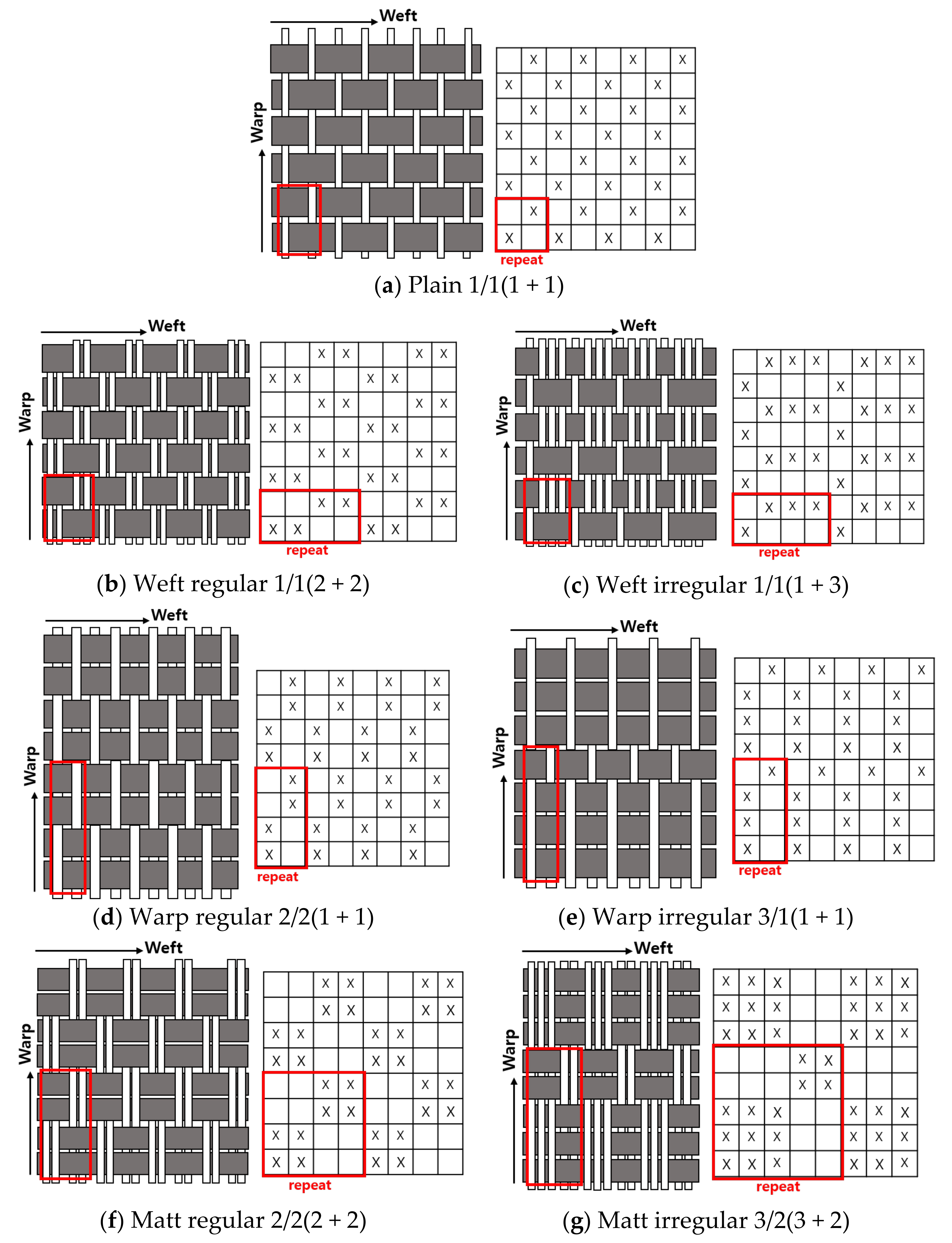

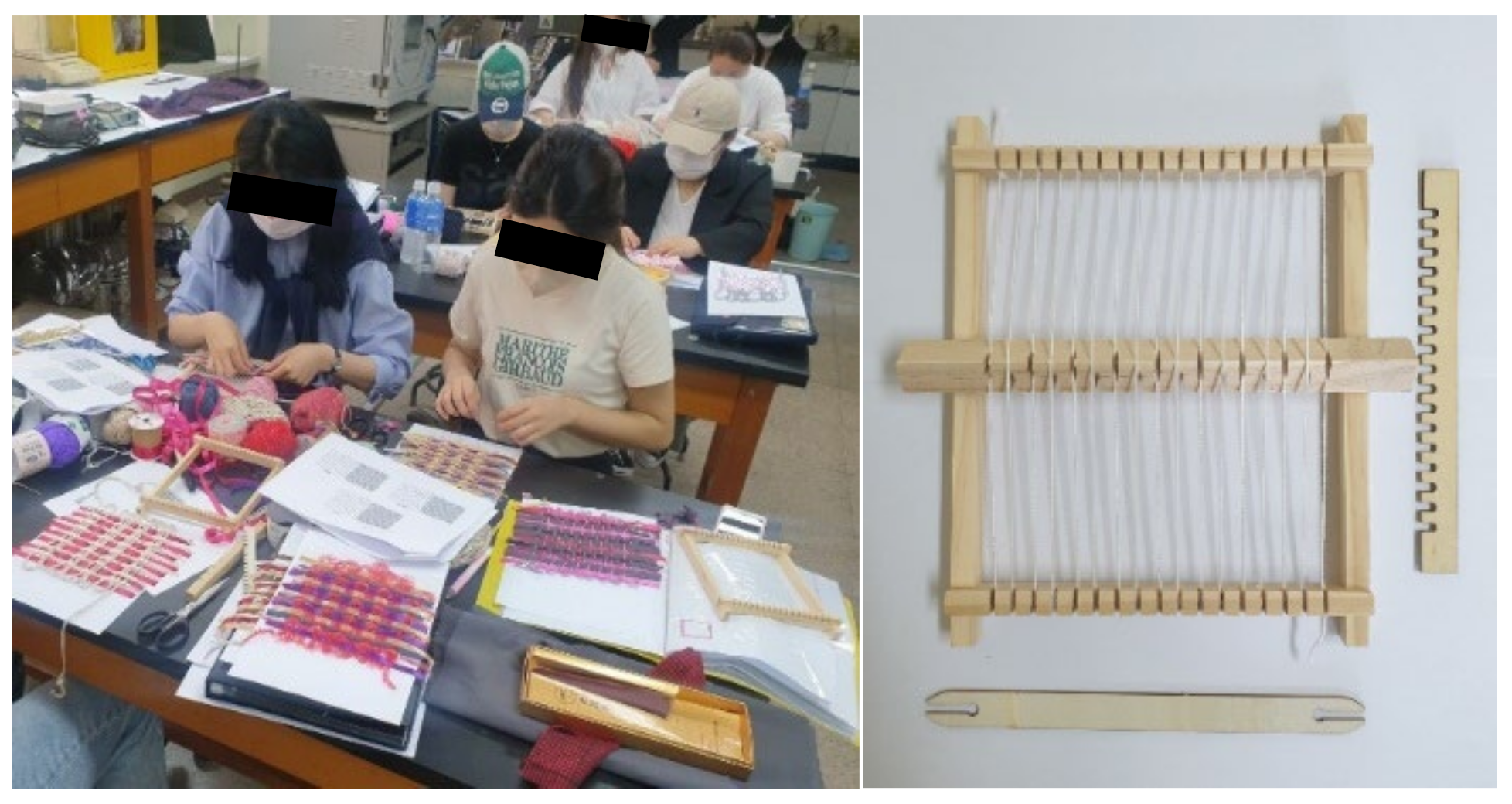
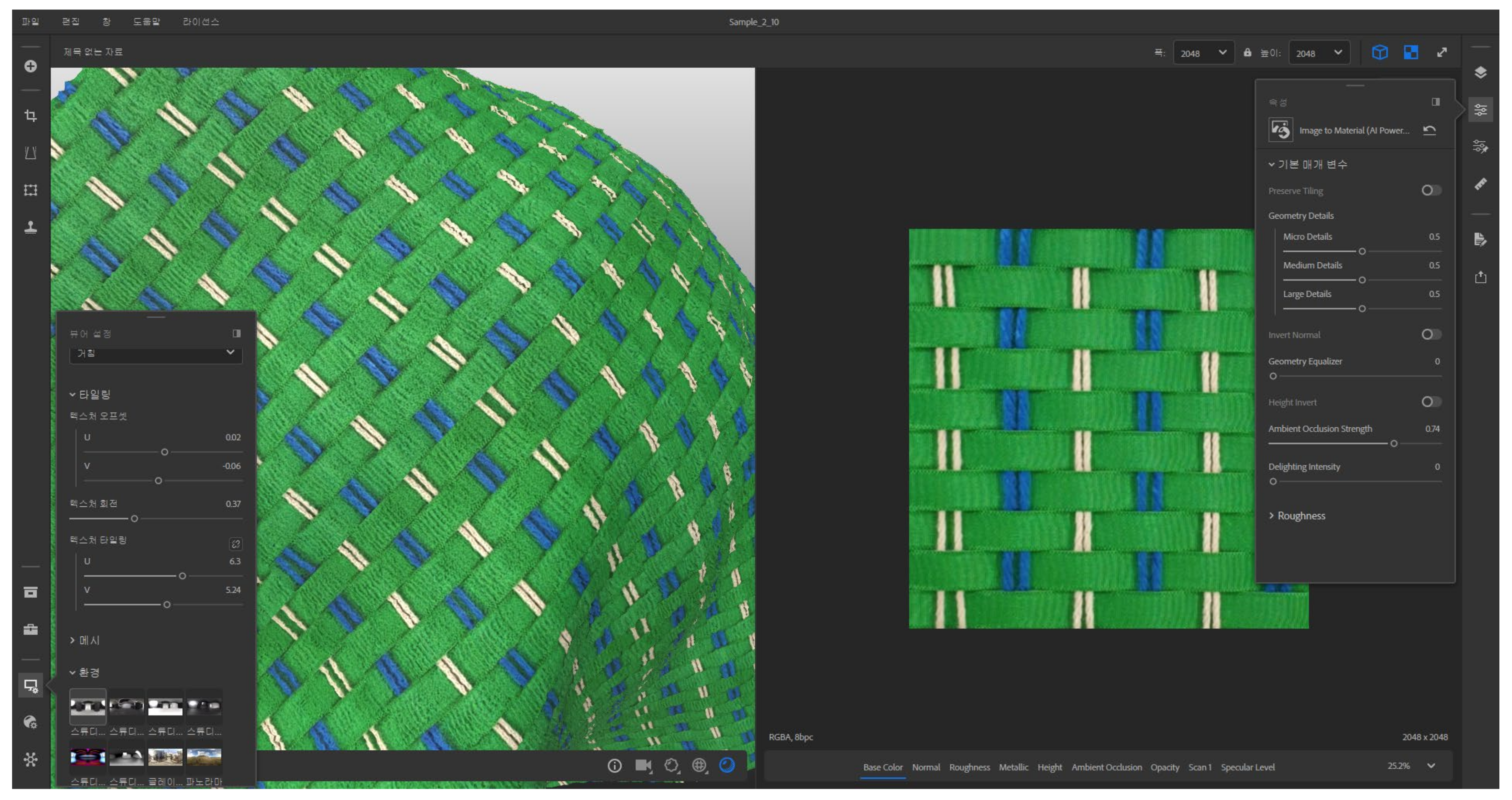

| Questions | Answers(n = 20) |
|---|---|
| 1. Whether waste has been generated within the past year | - Generated (75%, n = 15) - Not generated (5%, n = 1) - Not recognized as generating clothing waste (20%, n = 4) |
| 2. Place of clothing waste production | - At home (70%, n = 14) - Outside the home (30%, n = 6) |
| 3. Type of clothing waste | - Fabric (20%, n = 4), clothing (50%, n = 10), etc. (30%, n = 6) - Other: packaging ribbon tapes, nonwoven fabrics, and household goods |
| 4. The necessity of recycling clothing waste | - Necessary (90%, n = 18) - Unnecessary (10%, n = 2) |
| 5. Reasons for answering that recycling clothing waste is necessary or unnecessary (except for environmental reasons) | - The answers from the persons who responded “necessary” include: “I have memories choosing clothes or fabrics very carefully at the time”, “The cloth I have was still a good product that was not enough to be thrown away”, “It was out of fashion but not aesthetically bad”. - The answers from the persons who responded “unnecessary” include: “I do not think clothing waste will turn pretty even if it’s recycled, and it will eventually be thrown away”. |
| 6. Knowledge of methods of recycling clothing waste | - Know how to recycle (20%, n = 4) - Do not know how to recycle (80%, n = 16) |
| 7. The methods of recycling clothing waste that you know (only those who answered “I know” in Question 6, n = 4) | - Reusing packaged ribbon tape, using for other purposes, such as sunshades, fabric rugs, or dishcloth mobs (n = 3) - Dismantling, cutting, and sewing fabric products to make other products (n = 1) |
| Evaluation Factors | Questions | Evaluator | ||
|---|---|---|---|---|
| Materials | - Ease of material preparation | Q: Is the preparation process of the cloth tape to be used easy? A: 1(very easy)—2(easy)—3(normal)—4(little difficult)—5(difficult) | Participant of weaving process, 3D virtual fashion production experts | |
| - Suitability of material use | Q: How suitable is the cloth tape for the production of creative textiles? A: 1(unsuitable)—2(slightly unsuitable)—3(normal)—4(slightly suitable)—5(suitable) | |||
| Weaving methods | - Total difficulty level - Difficulty level of each method | Q: How difficult is the weaving method to produce using cloth tape? A: 1(very easy)—2(easy)—3(normal)—4(little difficult)—5(difficult) | ||
| Results | Novelty | Unexpectedness and originality | Q1: How unexpected and original is this creative textile and 3D virtual textile? A: 1(poor)—2(slightly poor)—3(normal)—4(good)—5(very good) | 3D virtual fashion production experts |
| Differentiation and aesthetic | Q: How different and aesthetic is this creative textile and 3D virtual textile? A: 1(poor)—2(slightly poor)—3(normal)—4(good)—5(very good) | |||
| Appropriateness | Practicality and commodity | Q: How practical and commercially viable is this creative textile and 3D virtual textile? A: 1(poor)—2(slightly poor)—3(normal)—4(good)—5(very good) | ||
| Sustainability and upcycling success of creative work | Q: How successful is this creative textile and 3D virtual textile in terms of sustainability and upcycling? A: 1(poor)—2(slightly poor)—3(normal)—4(good)—5(very good) | |||
| Expert | Education | Occupation | Three-Dimensional Virtual Fashion Production Experience |
|---|---|---|---|
| A | Bachelor’s degree | 3D virtual fashion designer | 5.5 years |
| B | Bachelor’s degree | 3D virtual fashion designer | 7 years |
| C | Master’s degree | 3D virtual fashion designer | 10 years |
| D | Master’s degree | Lecturer and fashion designer | 5.5 years |
| E | Doctor’s degree | Professor | 5 years |
| F | Doctor’s degree | Professor | 6.5 years |
| G | Doctor’s degree | Professor | 5 years |
| Novelty | Rank | 1 | 2 | 3 | 4 | 5 |
| Creative textiles | 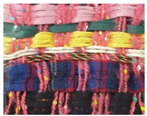 | 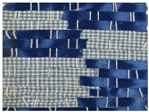 |  |  | 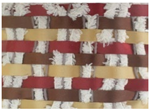 | |
| 3D virtual textiles |  | 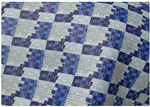 | 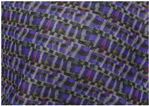 | 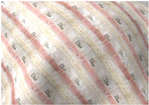 | 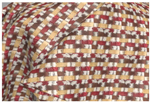 | |
| Methods | Matt irregular | Weft regular | Warp irregular | Matt irregular | Weft irregular | |
| Rank | 6 | 7 | 8 | 9 | 10 | |
| Creative textiles |  |  |  |  | 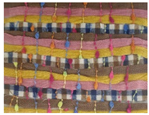 | |
| 3D virtual textiles | 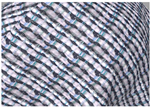 | 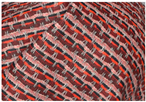 | 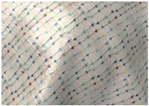 |  | 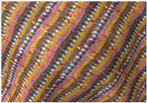 | |
| Methods | Matt regular | Matt irregular | Matt irregular | Warp irregular | Warp irregular | |
| Appropriateness | Rank | 1 | 2 | 3 | 4 | 5 |
| Creative textiles | 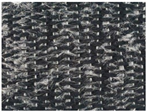 | 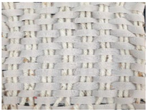 |  |  | 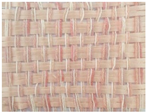 | |
| 3D virtual textiles | 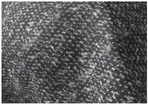 |  |  | 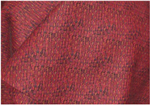 |  | |
| Methods | Plain | Weft regular | Plain | Plain | Matt irregular | |
| Rank | 6 | 7 | 8 | 9 | 10 | |
| Creative textiles | 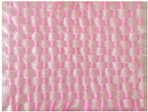 | 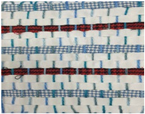 |  |  | 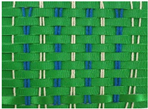 | |
| 3D virtual textiles | 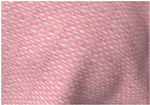 | 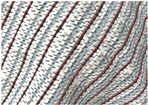 | 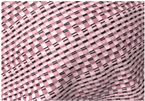 | 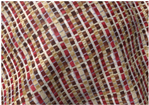 |  | |
| Methods | Plain | Plain | Weft regular | Plain | Weft regular |
Disclaimer/Publisher’s Note: The statements, opinions and data contained in all publications are solely those of the individual author(s) and contributor(s) and not of MDPI and/or the editor(s). MDPI and/or the editor(s) disclaim responsibility for any injury to people or property resulting from any ideas, methods, instructions or products referred to in the content. |
© 2023 by the author. Licensee MDPI, Basel, Switzerland. This article is an open access article distributed under the terms and conditions of the Creative Commons Attribution (CC BY) license (https://creativecommons.org/licenses/by/4.0/).
Share and Cite
Lee, H.W. Development of Sustainable Creative Three-Dimensional Virtual Woven Textiles Using Clothing Waste. Sustainability 2023, 15, 2263. https://doi.org/10.3390/su15032263
Lee HW. Development of Sustainable Creative Three-Dimensional Virtual Woven Textiles Using Clothing Waste. Sustainability. 2023; 15(3):2263. https://doi.org/10.3390/su15032263
Chicago/Turabian StyleLee, Hye Won. 2023. "Development of Sustainable Creative Three-Dimensional Virtual Woven Textiles Using Clothing Waste" Sustainability 15, no. 3: 2263. https://doi.org/10.3390/su15032263
APA StyleLee, H. W. (2023). Development of Sustainable Creative Three-Dimensional Virtual Woven Textiles Using Clothing Waste. Sustainability, 15(3), 2263. https://doi.org/10.3390/su15032263









